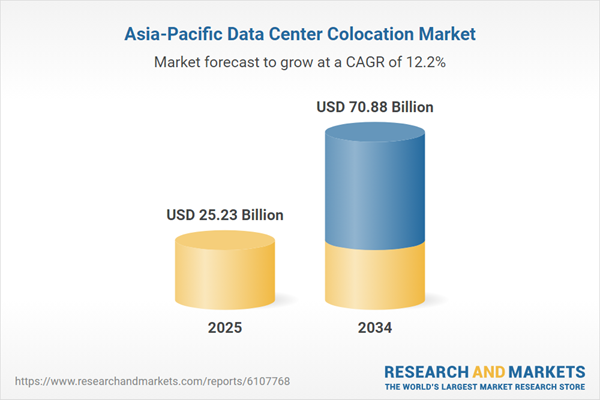This report comes with 10% free customization, enabling you to add data that meets your specific business needs.
Market Introduction
The market for data centre colocation in Asia Pacific has grown rapidly as businesses and service providers seek to reduce costs and streamline operations. Without having to worry about creating and maintaining their own data halls, colocation facilities give businesses the chance to take advantage of professionally managed settings with high-bandwidth connectivity, reliable security measures, and redundant power supply. Small and medium-sized enterprises (SMBs) who need enterprise-grade infrastructure but lack the funds to invest in private projects are most affected by this trend.The demand for geographically diversified hosting sites has increased due to the rapid rise of digital services such as e-commerce, online gambling, streaming media, and fintech. As a result, established centres like Singapore and Tokyo are developing alongside new markets like Jakarta, Kuala Lumpur, Mumbai, and Ho Chi Minh City. Both local operators and international hyperscalers find these secondary markets to be appealing options due to their improved fibre networks, reduced real estate costs, and advantageous government subsidies.
Colocation operators are rapidly incorporating value-added services like managed security, disaster recovery, and cross-connect fabric connectivity to cloud providers in addition to supporting traditional workloads. In the future, it is anticipated that modular "build-as-you-grow" designs and AI-driven monitoring tools would improve operational efficiency and scalability. Even if there are still issues with power availability and compliance, continued infrastructure expenditures and strategic alliances set up APAC's colocation market for long-term expansion over the following five years.
Market Segmentation
Segmentation 1: by Application
- IT and Telecom
- Banking, Financial Services, and Insurance (BFSI)
- Government and Public Sector
- Healthcare
- Manufacturing
- Retail
- Others
Segmentation 2: by Business Model
- Retail
- Wholesale
Segmentation 3: by Region
- Asia-Pacific: China, Japan, Australia, India, South Korea, and Rest-of-Asia-Pacific
APAC Data Center Colocation Market Trends, Drivers and Challenges
Trends
- Decentralization to Tier 2/3 markets as hyperscalers and enterprises expand beyond traditional hubs.
- Surge in AI‑ready infrastructure with growing demand for high‑density compute and AI‑optimized facilities.
- Enhanced submarine connectivity boosting inter‑regional data flow and colocation adoption.
- Shift toward sustainable operations through renewable energy integration, efficient cooling, and green certifications.
Drivers
- Rapid cloud adoption and digital transformation increasing demand for scalable colocation solutions.
- Booming e‑commerce and a vibrant startup ecosystem driving localized data center needs.
- Government support and data‑sovereignty policies encouraging local colocation investments.
- Significant hyperscaler investments from AWS, Microsoft Azure, Google Cloud, and others expanding into emerging APAC regions.
Challenges
- Limited land availability in prime markets, forcing developers to seek less‑mature locations.
- Power and energy constraints, with grids struggling to support increasing data center loads.
- Diverse regulatory and compliance requirements across APAC complicating site selection and approvals.
- Rising capital and operational costs (land, labor, materials, power, cooling) affecting return‑on‑investment.
How can this report add value to an organization?
Product/Innovation Strategy: The APAC data center colocation market is segmented based on diverse applications, business models, and operator types, providing insights into its broad range of use cases. Key applications include IT and telecom, banking, financial services, insurance (BFSI), government, healthcare, manufacturing, retail, and others, each benefiting from scalable, secure, and reliable colocation services. The market also distinguishes between retail colocation, which caters to smaller businesses requiring flexible solutions, and wholesale colocation, designed for large-scale enterprises with high-volume data needs. Additionally, operators are categorized as global, offering extensive network coverage and robust infrastructure, or regional, providing localized services tailored to specific market demands. Continuous technological advancements, such as energy-efficient cooling, automation, and enhanced security features, are expected to drive the market’s growth, providing substantial opportunities for industry players to expand their offerings and strengthen their market position in this rapidly evolving sector.Growth/Marketing Strategy: The APAC data center colocation market has been growing at a rapid pace. The market offers enormous opportunities for existing and emerging market players. Some of the strategies covered in this segment are mergers and acquisitions, product launches, partnerships and collaborations, business expansions, and investments. The strategies preferred by companies to maintain and strengthen their market position primarily include product development.
This product will be delivered within 2 business days.
Table of Contents
Table Information
| Report Attribute | Details |
|---|---|
| No. of Pages | 59 |
| Published | June 2025 |
| Forecast Period | 2025 - 2034 |
| Estimated Market Value ( USD | $ 25.23 Billion |
| Forecasted Market Value ( USD | $ 70.88 Billion |
| Compound Annual Growth Rate | 12.1% |
| Regions Covered | Asia Pacific |









